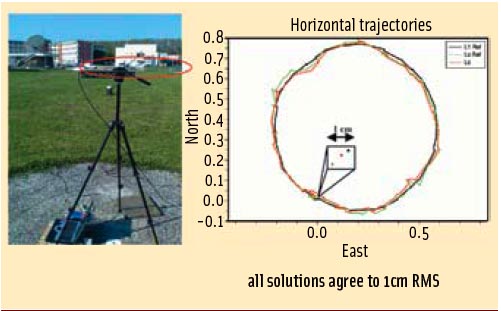Figures 1 – 4: Integrity for Aviation
Return to main article: “Integrity for Aviation”
By Inside GNSSReturn to main article: “Integrity for Aviation”
By Inside GNSSIn a part of the world where frustrated drivers will park anywhere, including squarely on a sidewalk, a local newspaper is using location data to shame car owners into shaping up.
The Village, a Russian online publication serving Moscow, St. Petersburg and Kiev; created a free app that notes a badly parked vehicle’s make, color, and license plate information when users snap its picture.
By Dee Ann Divis
Q: What is a maximum likelihood vector tracking receiver?
A: Vector tracking in GNSS receivers is based on the idea that instead of tracking each satellite’s signal separately, all signals are ultimately related to the position and velocity of the user antenna and thus can be tracked collectively. (See the discussion in this column in Sept/Oct 2012 issue of Inside GNSS by Drs. Lashley and Bevly for more information.)
By Inside GNSS
Every breath you take . . .
Every move you make
Every step you take
I’ll be watching you
I originally planned on titling this column, “Waiting to Inhale,” recalling these lyrics and an editorial I wrote more than four years ago about my sense of relief at the departure of the second Bush administration.
I called that one, “Waiting to Exhale.”
By Inside GNSS Equations
EquationsWorking Papers explore the technical and scientific themes that underpin GNSS programs and applications. This regular column is coordinated by Prof. Dr.-Ing. Günter Hein, head of Europe’s Galileo Operations and Evolution.
By Inside GNSSIt’s all about the backups now. The alternatives. The gap-fillers.
Back in the 1990s, when I first came across the U.S. Federal Radionavigation Plan (FRP), I learned that the rise of the Global Positioning System drove the biannual FRP process because of the expectation that GPS would enable the government to shut down many pieces in the hodgepodge of positioning, navigation, and timing (PNT) systems.
By Inside GNSS
Honestly, one gets the feeling that the European navigation community has finally had enough of talking and is ready to take Galileo out of the hands of politicians and put it into the hands of users, including businesses that can translate European GNSS into real products and services to be bought and sold.
The feeling has certainly been growing within the European navigation community, as evidenced by the conversations at the recent European Navigation Conference (ENC) in Vienna.
By Peter Gutierrez
Q: How do you deal with timing differences between GNSSs?
A: All GNSSs inherently depend on precise timekeeping to measure the satellite/receiver time of flight of signal propagation with sufficient accuracy to compute ranges/distances for multilateration calculations. Each GNSS ground segment therefore dedicates considerable effort to maintaining a highly stable atomic time scale as well as the corresponding offset to global standards such as UTC (Coordinated Universal Time).
By Inside GNSS FIGURE 1: ISTA (left) and GATE (right) measuring vans at the parking place at the GATE site in Berchtesgaden
FIGURE 1: ISTA (left) and GATE (right) measuring vans at the parking place at the GATE site in BerchtesgadenWorking Papers explore the technical and scientific themes that underpin GNSS programs and applications. This regular column is coordinated by Prof. Dr.-Ing. Günter Hein, head of Europe’s Galileo Operations and Evolution.
For the complete story, including figures, graphs, and images, please download the PDF of the article, above.
By Inside GNSSReturn to main article: "Assessing GNSS Data Message Performance"
By Inside GNSS